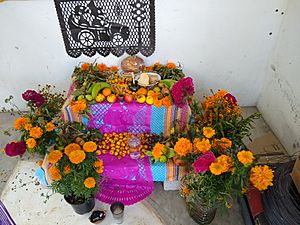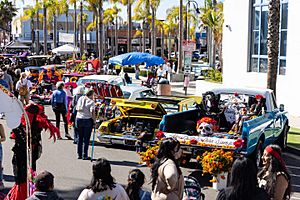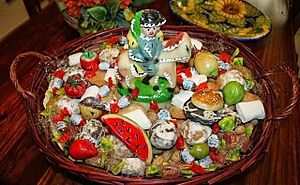Day of the Dead facts for kids
Quick facts for kids Day of the Dead |
|
|---|---|

Día de Muertos altar commemorating a deceased man in Milpa Alta, Mexico City
|
|
| Observed by | Mexico, and regions with large Mexican populations |
| Type |
|
| Significance | Prayer and remembrance of friends and family members who have died |
| Celebrations | Creation of home altars to remember the dead, traditional dishes for the Day of the Dead |
| Begins | November 1 |
| Ends | November 2 |
| Date | November 2 |
| Next time | 2 November 2025 |
| Frequency | Annual |
| Related to | All Saints' Eve / All Hallows' Eve, All Saints' Day / All Hallows' Day, All Souls' Day |
The Day of the Dead (in Spanish, el Día de Muertos) is a special holiday. It is usually celebrated on November 1 and 2. Sometimes, it can also include October 31 or November 6, depending on the place. This holiday is very popular in Mexico, where it first started. People of Mexican background in other countries also celebrate it.
This holiday is a time for families and friends to come together. They remember and honor loved ones who have passed away. It's a multi-day celebration that can be quite joyful. People often share funny stories and memories about those they are remembering.
During this time, people honor the dead using special items. These include calaveras (skulls) and bright orange marigold flowers. Families build altars at home called ofrendas. They put favorite foods and drinks of the departed on these altars. Many also visit graves with these items as gifts. People also give gifts to friends, like candy sugar skulls. They share a special bread called pan de muerto. Sometimes, they write funny poems called calaveras literarias about living friends.
In 2008, UNESCO added the Day of the Dead to its list. This list recognizes important cultural traditions around the world.
Contents
What are the roots of Day of the Dead?
The Day of the Dead has become a national symbol in Mexico. It is taught in schools as having old native roots. However, experts have different ideas about where it truly comes from. Some think it started with ancient Indigenous Mexican people like the Aztecs. Others believe it's more like a Spanish tradition that changed over time. It might also be a mix of both.
The Christian holidays of All Saints' Day and All Souls' Day are celebrated around the same time. These are observed in places like Spain and other Catholic countries. Some researchers say that even though ancient Mexico honored the dead, today's celebrations look more like European traditions. These European traditions often show skeletons to remind people that life is short.
However, other experts say there is proof of similar celebrations in ancient Mexico. The Aztecs had several festivals for the dead throughout the year. One was called Quecholli, celebrated in late October or early November. It included placing altars with food, like tamales, near burial sites. This was to help warriors on their journey to the afterlife.
No matter its exact origin, the Day of the Dead is now a very important holiday in Mexico. It is taught in schools and is a nationwide school holiday.
How is Day of the Dead celebrated in Mexico?
Altars and displays in Mexico City
Many museums and public places in Mexico City help celebrate Day of the Dead. They create large altars and displays. These include places like the Anahuacalli Museum and The Frida Kahlo Museum. Big displays were also made in the Zocalo, Mexico City's main square. In recent years, a large parade has also become part of the celebration. This parade was inspired by a James Bond movie!
What are ofrendas (altars)?
During Day of the Dead, families build private altars called ofrendas. These altars have favorite foods, drinks, photos, and special items of the people who have died. The idea is to invite the souls of the dead to visit. This way, the souls can hear the prayers and words of their living family.
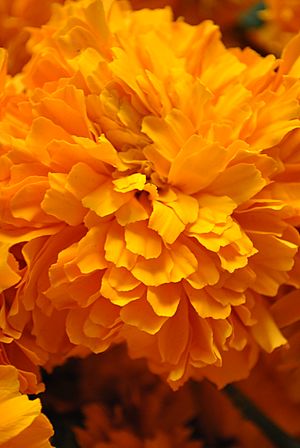
People plan for this day all year, gathering things for the offerings. Families clean and decorate graves. They visit cemeteries and place ofrendas on the graves. These often include bright orange Mexican marigolds called cempasúchil. These flowers are thought to attract the souls of the dead. Their bright petals and strong scent are believed to guide souls from cemeteries to their homes.
Families bring toys for children who have passed away, called los angelitos (the little angels). For adults, they bring bottles of tequila or mezcal, or jars of atole. They also offer small gifts or the person's favorite candies. Many homes have ofrendas with foods like candied pumpkin, pan de muerto (bread of the dead), and sugar skulls. Drinks like atole are also common. These ofrendas welcome the deceased. Some believe the spirits eat the "spiritual essence" of the food. After the festivities, the living eat the food, but it's thought to have lost its "spiritual" nutrition. Pillows and blankets are left out so the dead can rest. In some towns, like Mixquic, people stay all night by the graves. Many families also have picnics at the grave site.
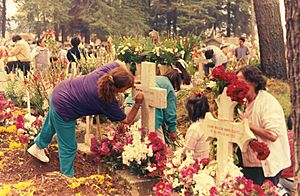
Some families build altars or small shrines in their homes. These might have a Christian cross, pictures of the Blessed Virgin Mary, photos of dead relatives, candles, and an ofrenda. Families often spend time around the altar, praying and sharing stories about the deceased. In some places, people wear shells on their clothes. When they dance, the noise is meant to wake up the dead. Some people also dress up as the deceased.
What special foods are eaten?
Food is very important during Day of the Dead. It's eaten by living people and offered to the spirits. Tamales are a common dish made for both purposes.
Pan de muerto and calaveras are especially linked to Day of the Dead. Pan de muerto is a sweet bread shaped like a bun. It's topped with sugar and often decorated with bone-shaped pieces of dough. Calaveras, or sugar skulls, have colorful designs. They show the unique personality of the person who passed away.
Drinks are also a key part of the tradition. In the past, pulque was the main alcoholic drink. Today, families often drink the favorite beverage of their ancestors. Other holiday drinks include atole and champurrado. These are warm, thick, non-alcoholic drinks made from masa (corn dough).
Agua de Jamaica (hibiscus water) is a popular cold, sweet herbal tea. It's made from the flowers of the Jamaican hibiscus plant.
In the Yucatán Peninsula, mukbil pollo is a special dish. It's like a big tamale, made with corn dough and pork lard. It's filled with pork, chicken, and many spices. This dish is cooked in an underground oven for several hours.
What are Calaveras?
A common symbol of the holiday is the skull, called calavera in Spanish. People use skulls in masks, called calacas (skeletons). They also make foods like chocolate or sugar skulls. These sugar skulls often have the name of a person written on the forehead. Sugar skulls can be given as gifts to both living friends and to remember the dead.
What is Calaverita?
In some cities, children dress up in costumes. They go from door to door asking for a calaverita. This is a small gift of candies or money. They also ask people passing by for gifts. This is similar to Halloween's trick-or-treating in the United States. But it doesn't involve playing tricks if no treat is given.
What are Calaveras literarias (literary skulls)?
A unique part of this holiday is writing short, rhyming poems. These are called calaveras literarias (meaning "literary skulls"). They are funny, light-hearted poems that are like mock epitaphs. They are usually written for friends, classmates, co-workers, or family members (living or dead). They describe funny habits or stories about the person. These poems use images related to death, like cemeteries or the grim reaper.
This custom started in the 18th or 19th century. Today, newspapers publish calaveras literarias about public figures. They often include cartoons of skeletons, like the famous ones by José Guadalupe Posada. In schools, students are often asked to write them for language class.
Posada's most famous drawing is La Calavera Catrina ("The Elegant Skull"). It was probably meant to criticize wealthy Mexican women who copied European styles. Later, the famous Mexican artist Diego Rivera painted Catrina as a full figure. He added features that honored the native people of Mexico. This made Catrina a symbol of Mexican pride.
The Catrina character is now strongly linked to the Day of the Dead. You can see Catrina figures made from many materials. People also dress up in Catrina costumes. The Catrina has become so popular that you can find her image on many things, even outside of the holiday.
Local traditions
Day of the Dead traditions can be different from town to town. For example, in Pátzcuaro, the celebration changes if the person who died was a child or an adult. If a child died in the past year, their godparents set up a table at the parents' home. It has sweets, fruits, pan de muerto, a cross, a rosary, and candles. This celebrates the child's life. There is also dancing with colorful costumes and skull masks in the town square.
At midnight on November 2, people light candles. They ride special boats called mariposas (butterflies) to Janitzio Island. There, they visit the cemetery to honor the dead.
In Ocotepec, people open their homes to visitors. In return, visitors bring small wax candles called veladoras to show respect for someone who recently died in that house. The visitors then receive tamales and atole. This is only done by families who had a death in the past year.
Another tradition is La Danza de los Viejitos (the Dance of the Old Men). Young boys and men dress like grandfathers. They crouch and jump in an energetic dance.
In the 2015 James Bond movie Spectre, there was a Day of the Dead parade in Mexico City. At that time, no such parade existed. But because of the movie's popularity, the government decided to create a real parade in 2016. It was a huge success, with 250,000 people attending! The Disney Pixar movie Coco also helped make the idea of a big celebration popular.
How is Day of the Dead celebrated outside Mexico?
United States

In many U.S. cities with Mexican communities, Day of the Dead celebrations are very similar to those in Mexico. In states like Texas, New Mexico, and Arizona, the celebrations are often very traditional. For example, in Tucson, Arizona, the All Souls Procession has been held every year since 1990. People wear masks and carry signs honoring the dead. They also carry an urn where people can put prayers to be burned.
In Santa Ana, California, the annual Noche de Altares is said to be the "largest event in Southern California." It started in 2002.
In other places, like Los Angeles, California, Mexican traditions mix with American culture. Celebrations can become artistic or even political. For example, altars might honor victims of war. At Hollywood Forever Cemetery, traditional altars are set up next to altars for famous people. Dancers and music mix with performance artists.
Similar celebrations happen in San Francisco and Oakland. Oakland's Fruitvale district has an annual Día de Muertos festival. It features Aztec dancers, Mexican music, and artisans.
In San Diego, California, which is close to Mexico, celebrations happen all over the county. In Oceanside, there are community altars and events at the Civic Center. In City Heights, there's a public festival with many altars, lowriders, and entertainment. In Chula Vista, they have a movie night showing "Coco," along with a community altar and contests.
Italy
In Italy, November 2 is All Souls' Day, also called "Giorno dei Morti" (Day of the Dead). People place flowers at cemeteries and talk to their deceased relatives. Some traditions include lighting a red candle on windowsills at sunset. They also lay out food for deceased relatives who might visit. This day helps teach children not to be afraid of death.
In Sicily, families celebrate "Festa dei Morti" (Festival of the Dead). On the night before November 2, older family members pretend to be the "defunti" (spirits of the dead). They hide sweets and gifts for children to find in the morning. Children look for these gifts in shoes or a special basket called "cannistru dei morti." The basket usually has sweets, small toys, bone-shaped cookies, sugar dolls, and fruit-shaped marzipan treats. After finding gifts, families visit the cemetery with flowers and light candles. They thank the deceased for the gifts.
Food is a big part of Italy's Day of the Dead. Different regions have special treats. In Tuscany, "pane dei morti" (bread of the dead) is a common offering. In Sicily, families enjoy special cakes and cookies shaped like skulls and finger bones.
Philippines
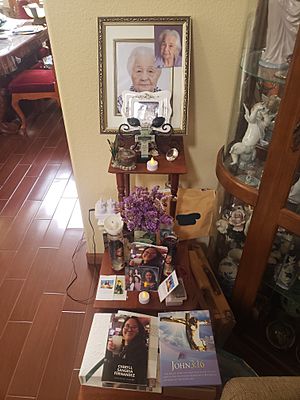
Because of the close history between the Philippines and Mexico, the Day of the Dead is also celebrated there. In the Philippines, it's called "Undás" or "Araw ng mga Yumao" (Day of those who have died). It happens on All Saints' Day and All Souls' Day. Filipinos visit family graves to clean and fix them, just like in Mexico. They offer prayers, flowers, candles, and food. Many also spend the day and night having family reunions at the cemetery.
Czech Republic
In Prague, Czech Republic, some people celebrate a Mexican-style Day of the Dead. This started with promotions by the Mexican embassy. A theater group holds events with candles, masks, and face paint that looks like sugar skulls.
Other similar celebrations
Americas
Belize
In Belize, the Day of the Dead is celebrated by the Yucatec Maya people. It's called Hanal Pixan, which means 'food for the souls'. Altars are built and decorated with food, drinks, candies, and candles.
Bolivia
Día de las Ñatitas ("Day of the Skulls") is a festival in La Paz, Bolivia. It happens in early November. In ancient times, people in the Andes would spend a day with the bones of their ancestors. Today, families keep only the skulls for these rituals. They believe the skulls watch over and protect the family. On November 9, families crown the skulls with fresh flowers and offer gifts to thank them. The skulls are sometimes taken to the cemetery for a special blessing.
Brazil
Brazil celebrates Dia de Finados or Dia dos Mortos (Day of the Dead) on November 2. People go to cemeteries and churches with flowers and candles. They offer prayers. It's a positive way to honor the dead. This celebration mixes native and European Catholic traditions.
Costa Rica
Costa Rica celebrates Día De Los Muertos on November 2. It's also called Día de Todos Santos (All Saints Day) and Día de Todos Almas (All Souls Day). Catholic church services are held. People visit their loved ones' graves and decorate them with flowers and candles.
Ecuador
In Ecuador, the Day of the Dead is important, especially for the native Kichwa people. Families gather at the cemetery with food offerings. They spend the day remembering their ancestors. Special foods include colada morada, a purple fruit drink, and wawa de pan, bread shaped like a baby. Many non-native Ecuadorians also visit graves, clean them, and bring flowers.
Guatemala
Guatemalan celebrations on November 1 include building and flying giant kites. Flying kites is believed to help spirits find their way back to Earth. Some kites even have notes for the dead attached to them. A big meal called fiambre is also eaten only on this day. People visit graves, decorating them with flowers, candles, and food. In some towns, people repair and repaint the cemetery with bright colors. Some families also have picnics at the cemetery.
Peru
In Peru, people often visit the cemetery. They play music and bring flowers to decorate the graves of their dead relatives.
Images for kids
See also
- Danse Macabre
- Samhain
- Walpurgis Night
- In Spanish: Día de Muertos para niños



